University Foodservice Tour of Whatcom County Producers
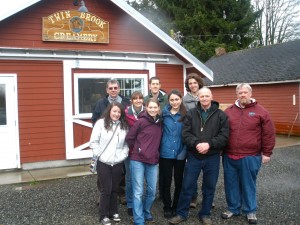 For the past 9 months, NABC has been partnering with the Real Food Challenge, working together to get more locally-produced and community-based products into college and university dining service in WA. The goal of each campus taking on the Real Food Challenge is to shift 20% of their existing dining budget to Real Food. This shift is done incrementally by replacing generic, mass-produced food products often purchased by institutional foodservice with better (local and community-based, more ecologically sound, and more humane) alternatives. NABC’s Emma Brewster has been working with students and dining representatives at UW, WWU, The Evergreen State College, and the University of Puget Sound, among others, to facilitate these types of product switches by drawing on PSFN’s and NABC’s producer base. Up until now it’s been a lot of talking about logistical (price, distribution, packaging…) considerations, and on Saturday we finally got the schools out to the farms!
For the past 9 months, NABC has been partnering with the Real Food Challenge, working together to get more locally-produced and community-based products into college and university dining service in WA. The goal of each campus taking on the Real Food Challenge is to shift 20% of their existing dining budget to Real Food. This shift is done incrementally by replacing generic, mass-produced food products often purchased by institutional foodservice with better (local and community-based, more ecologically sound, and more humane) alternatives. NABC’s Emma Brewster has been working with students and dining representatives at UW, WWU, The Evergreen State College, and the University of Puget Sound, among others, to facilitate these types of product switches by drawing on PSFN’s and NABC’s producer base. Up until now it’s been a lot of talking about logistical (price, distribution, packaging…) considerations, and on Saturday we finally got the schools out to the farms!
Destination: Whatcom County. Stops: Belly Timber Bars and Twin Brook Creamery –– two local producers with retail-ready products and a whetted appetite for institutional customers.
Belly Timber
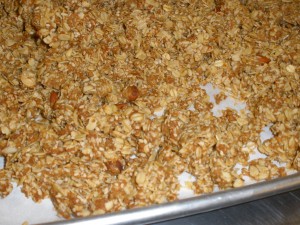 When Mary Goit’s youngest son turned two years old she decided she needed something to do. Something that would keep her busy and maybe even make a little money. One thing she did really really well was make granola. She and her sisters have used their mom’s secret granola recipe for years. Growing up they thought that they loved granola. As adults they realized that “No –– we don’t like granola. We like Mom’s granola!” And there was the idea.
When Mary Goit’s youngest son turned two years old she decided she needed something to do. Something that would keep her busy and maybe even make a little money. One thing she did really really well was make granola. She and her sisters have used their mom’s secret granola recipe for years. Growing up they thought that they loved granola. As adults they realized that “No –– we don’t like granola. We like Mom’s granola!” And there was the idea.
So Mary rented* time in a the commercial kitchen of a local cafe owned by a friend and started making granola to share with the masses. (*She earned her keep in the kitchen by scrubbing the cafe’s floors.) But granola can only take you so far — or rather, you can only take granola so far. Mary needed a way to make granola mobile. But, as a concerned environmentalist and practical family shopper she wanted to avoid lots of throwaway packaging like one-time use bowls. “How can I make granola for the road?” she thought. Then one night it came to her. BARS.
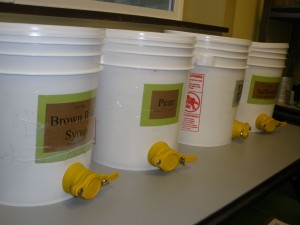 Mary and her husband developed the secret recipe for what are now Belly Timber Everyday Survival Bars based on what she had in her kitchen cabinets when the epiphany struck. Peanut butter. Toasted almonds. Brown rice syrup (“What on earth did we buy that for?”). Honey from her neighbor. Dates. This is largely the recipe that is still used today, and now there are several flavor varieties including peanut butter, blueberry, dark chocolate, and dark chocolate-espresso (organic and fair trade, of course!).
Mary and her husband developed the secret recipe for what are now Belly Timber Everyday Survival Bars based on what she had in her kitchen cabinets when the epiphany struck. Peanut butter. Toasted almonds. Brown rice syrup (“What on earth did we buy that for?”). Honey from her neighbor. Dates. This is largely the recipe that is still used today, and now there are several flavor varieties including peanut butter, blueberry, dark chocolate, and dark chocolate-espresso (organic and fair trade, of course!).
Mary sources as many ingredients as possible from her neighbors, and the vast majority are organic. Belly Timber bars are a great example of businesses working together to keep small scale food producers in business and in doing so, preserving farmland. Even the label was designed by several of Mary’s friends who were some of of the original 11 employees at Microsoft in Seattle. (Apparently they designed the original blue sky, clouds, and window logo for Windows and therefore have some time to kill and skills to share!) Between Mary and the designers, they personally know every individual adventurer pictured on the labels.
And the name? Allegedly it’s an old sailor (and possibly pirate…?) term for when time was tight and there was work to be done. Sailors needed solid fuel to climb the masts and take care of business, and the quick food they ate on the go when there wasn’t time for a meal was referred to as “Belly Timber.” (Go ahead, say it with a pirate accent… you know you want to). And there you have it: Belly Timber, the Every Day Survival Bar.
Every day, indeed. While the bars are adored by big-time adventurers who have taken them up Denali (finally — an energy bar that doesn’t freeze solid in the cold or melt into a mess in the heat!); bikers who’ve biked solo across the Rockies; and even the US Military, I can speak from experience that the bars are great for everyday snacking, on-the-go purse-stashing, and even stocking stuffing!
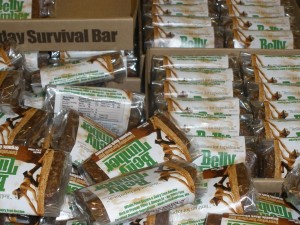
In addition to individual adventurers, some big-time customers have recently been hankering for some Belly Timber: the bars recently picked up by REI, and believe it or not, the Cincinnati Bengals (NFL) and now the Reds (MLB), too, are some of her biggest customers! According to the team’s strength and conditioning coach, the team was accustomed to eating Snickers bars before games and practices. As an athletic trainer, he thought that was a nutritional recipe for disaster. He did a simple internet search and came across Belly Timber. He thought they looked simple, healthful, and tasty and ordered a full case for the team. The team still prefers the chocolate and peanut butter varieties over other flavors of Belly Timber, but it’s a big improvement over candy bars! Mary knew her mom’s granola recipe and her product were good, but not THAT good. She says she’s never loved a football team so much!

And still, even with all these big name customers, Mary still manages to keep a reasonable schedule that works for her and her few employees. On Sundays they make the granola, and on Mondays they make the granola into bars. They’re usually done cleaning up the kitchen by 3:30 so everyone can go pick up their kids from school. (In fact, she almost didn’t let us come out and visit on a Saturday because that’s a day reserved for her and her employees to spend time with kids and family). The rest of the week is spent packaging, labeling, packing, and assessing inventory. A great deal of care is given to the product. Each and every bar is packed, sealed, labeled, and packed into boxes by hand. Mary still does all her own product demos, and is happy to answer calls from customers directly. She even puts her personal cell phone number on the label of every bar.
Check out these pictures of our visit to Belly Timber:
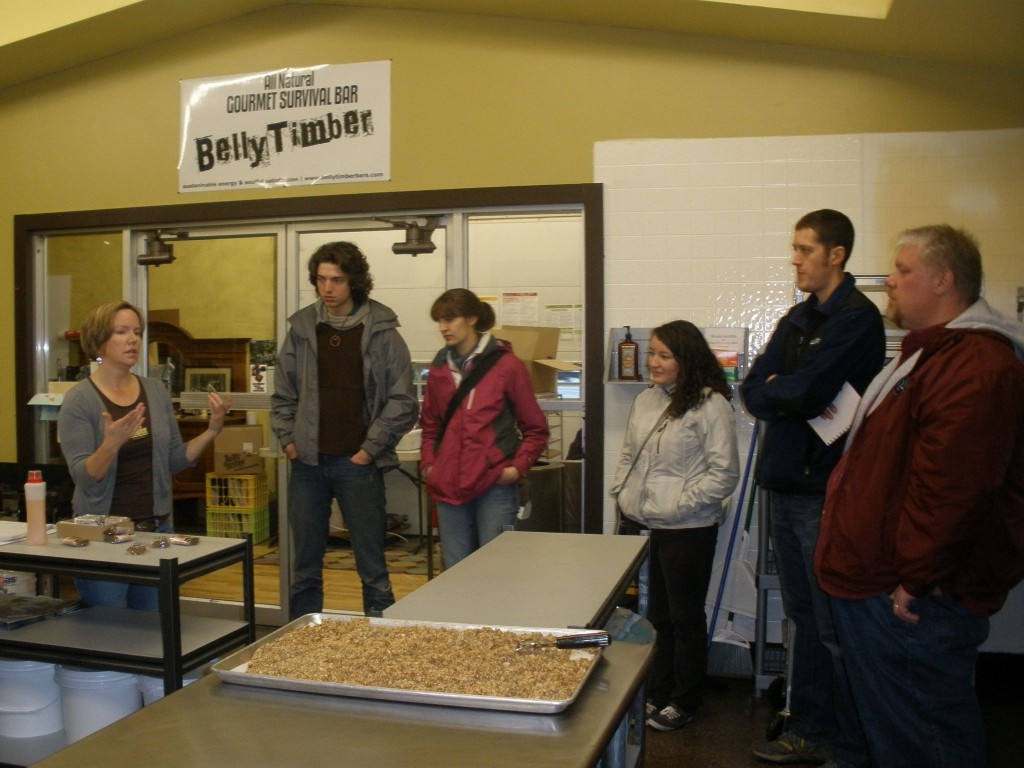
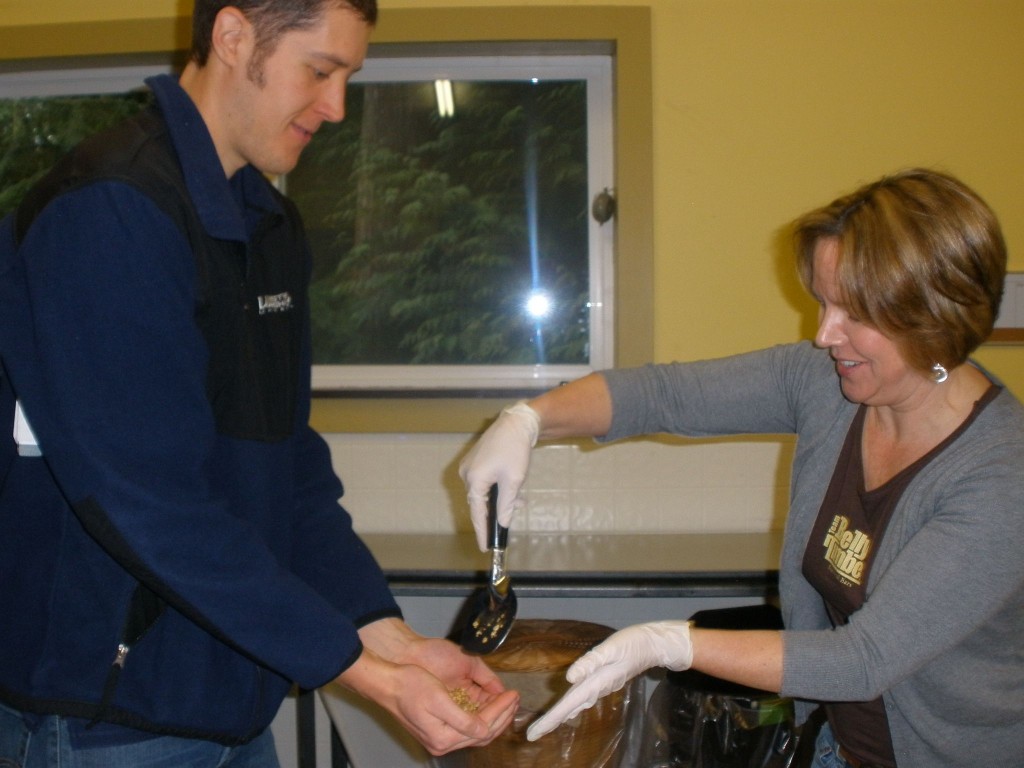
Belly Timber Bars are available at the PCC Natural Markets, Metropolitan Markets, the Community Food Co-op in Bellingham, smaller local retailers in WA, and REI stores across the nation.
Twin Brook Creamery
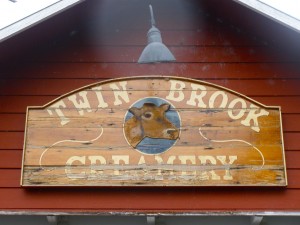 Next, it was off to Lynden (5 miles from the Canadian border!) to visit Larry Stap, owner and operator of Twin Brook Creamery!
Next, it was off to Lynden (5 miles from the Canadian border!) to visit Larry Stap, owner and operator of Twin Brook Creamery!
Larry, the oldest of four Stap brothers, is the 4th generation of Stap dairymen to farm on the same property that his great grandfather bought and built in 1910. In 2006 Larry’s daughter, Michelle, and her husband, Mark, asked Larry and his wife, Debbie, to be partners in the dairy business. Larry was hesitant at first. “I don’t want to get bigger and bigger. I don’t want to milk more cows and build more barns. So I said, ‘let’s think outside the box and find ourselves a niche’.” And that’s just what they did. Twin Brook milk is delicious and distinctive, and unlike any “competitor” in the area.
What makes it so great? The milk is gently pasteurized at low temperature for longer time than milk commonly found on grocery shelves. The hotter the pasteurization temperature, the more the milk gets cooked, which jeopardizes the authentic farm-fresh flavor. Some milk in grocery stores that has been pasteurized at high heat has a use-by date of up to 90 days after it was produced! In some grocery stores you can even find unrefrigerated milk on the shelves of center aisles. This is shelf-stable milk that has been heated at such high temperatures (upwards of 245º!) that merchandisers colloquially call it “dead milk” because there’s very little flavor or even much biological material left in it that would indicate that it was ever an animal product. This is isn’t the future of food Larry dreams of, and he’s sticking to his low heat methods. “We take our time and create a quality, authentic, good-tasting product. Now that’s ‘slow food’!” says Larry.
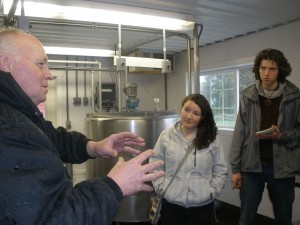
The low-temp pasteurization is just one aspect of production that differentiates Twin Brook’s milk from other products in the area. The second is that it’s not homogenized. Homogenization is the process of distributing the fat (cream) particles evenly throughout the milk so that the milk doesn’t separate, creating a cream top in the bottle. This is usually done by forcing a stream of milk through a tiny pipe or hole at incredibly fast speeds and under high pressure. This blasts apart the natural fat globules, dispersing their parts throughout the milk. This is no big deal for most of us, but from some consumers digesting milk in this altered state can wreak havoc on their digestive systems. In fact, Larry has gotten calls from several customers saying that they thought they were lactose-intolerant, but for some reason they have no problem drinking the milk from Twin Brook. Larry attributes this to the non-homogenization of his product.
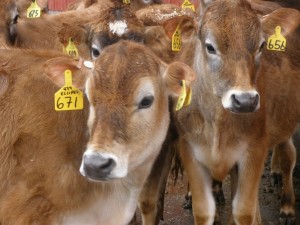 The third factor is that Larry milks only Jersey breed cows (not typical Holsteins). Jersey milk has a higher butter fat content, making the milk rich and flavorful, as well as a higher solids content. Solids are the non-fat protein particles in milk — the same protein material used to make cheese. This means that even the skim milk from Twin Brook is thicker, whiter, and more flavorful than other varieties, and doesn’t look like “blue-water” as Larry calls it. Not only is the milk for flavorful, but Jersey heffers are a smaller animal than typical dairy cows, meaning they eat less, produce less waste, and are less likely to get sick or injured. In fact, cows at Twin Brook live twice as long as the average milking cow. The cows are largely grass-fed with grass and hay produced on the farm, and are free to roam around outside in good weather. All the waste generated by the cows is applied to the pastures to fertilize the fields for more production. “Too many people consider manure a waste product to be gotten rid of,” Larry says, “…not an asset to completing the cycle.” These are all factors in running a fiscally and environmentally sustainable businesses.
The third factor is that Larry milks only Jersey breed cows (not typical Holsteins). Jersey milk has a higher butter fat content, making the milk rich and flavorful, as well as a higher solids content. Solids are the non-fat protein particles in milk — the same protein material used to make cheese. This means that even the skim milk from Twin Brook is thicker, whiter, and more flavorful than other varieties, and doesn’t look like “blue-water” as Larry calls it. Not only is the milk for flavorful, but Jersey heffers are a smaller animal than typical dairy cows, meaning they eat less, produce less waste, and are less likely to get sick or injured. In fact, cows at Twin Brook live twice as long as the average milking cow. The cows are largely grass-fed with grass and hay produced on the farm, and are free to roam around outside in good weather. All the waste generated by the cows is applied to the pastures to fertilize the fields for more production. “Too many people consider manure a waste product to be gotten rid of,” Larry says, “…not an asset to completing the cycle.” These are all factors in running a fiscally and environmentally sustainable businesses.
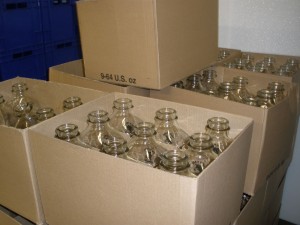 The final factor is the glass bottles that Twin Brook Milk is bottled in. Not only are the glass bottles returnable and re-usable, but they also don’t leech any chemicals into the milk and don’t affect the flavor of the milk at all. Like many health-conscious parents of that era and in the small New England town I grew up in, mine raised me and my sister on rBST-free skim milk produced in-state. It came in a white cardboard carton, which my parents loved because it wasn’t unnecessarily made of plastic and the carton was recyclable. Unfortunately, the taste of the paper infiltrated the milk, and to this day I associate the flimsy flavor of skim milk with bleached cardboard. Nothing to fear at Twin Brook, though. Between the glass packaging and the heightened flavor of the skim milk, I found it to be quite tasty with my chocolate chip cookies!
The final factor is the glass bottles that Twin Brook Milk is bottled in. Not only are the glass bottles returnable and re-usable, but they also don’t leech any chemicals into the milk and don’t affect the flavor of the milk at all. Like many health-conscious parents of that era and in the small New England town I grew up in, mine raised me and my sister on rBST-free skim milk produced in-state. It came in a white cardboard carton, which my parents loved because it wasn’t unnecessarily made of plastic and the carton was recyclable. Unfortunately, the taste of the paper infiltrated the milk, and to this day I associate the flimsy flavor of skim milk with bleached cardboard. Nothing to fear at Twin Brook, though. Between the glass packaging and the heightened flavor of the skim milk, I found it to be quite tasty with my chocolate chip cookies!
We were lucky to get a full tour of the bottling process from washing the returns (only soap and hot water –– no noxious rinsing chemicals –– are used) to filling the bottles. Larry says he gets roughly 75% of his bottles back. He attributes the lost bottles to the fact that “they’re just so darn cute, people want to keep em!” Cute they are, and they also happen to make great little water bottles. Not that I would know….
Check out these pictures of the full tour of Twin Brook!
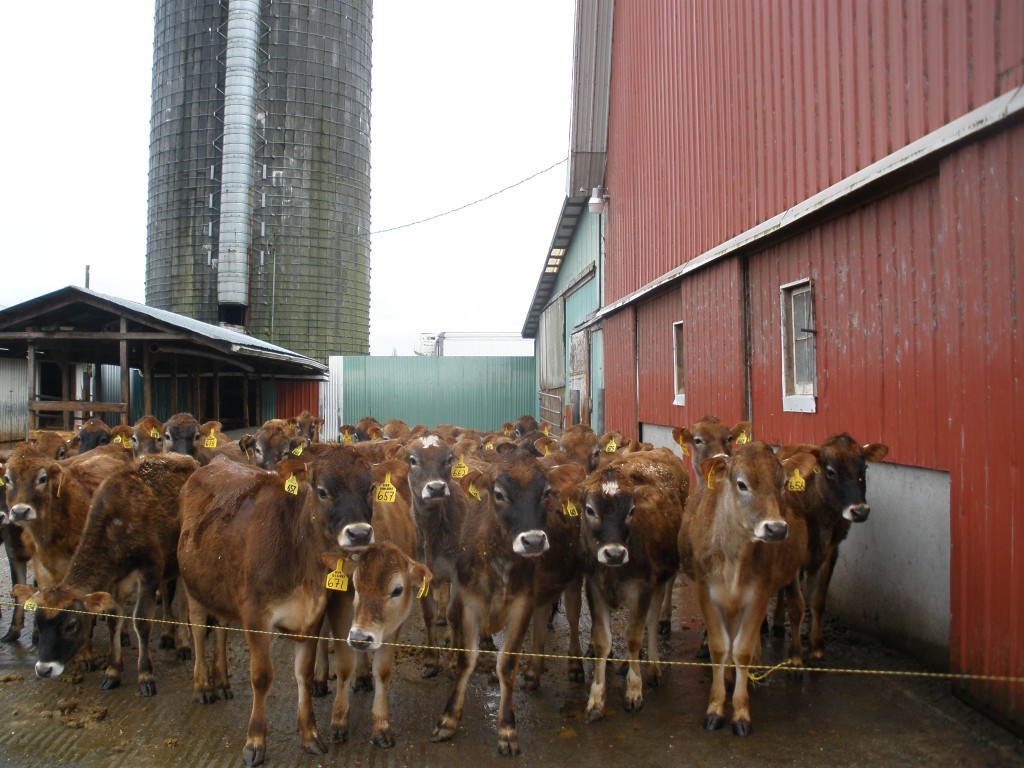
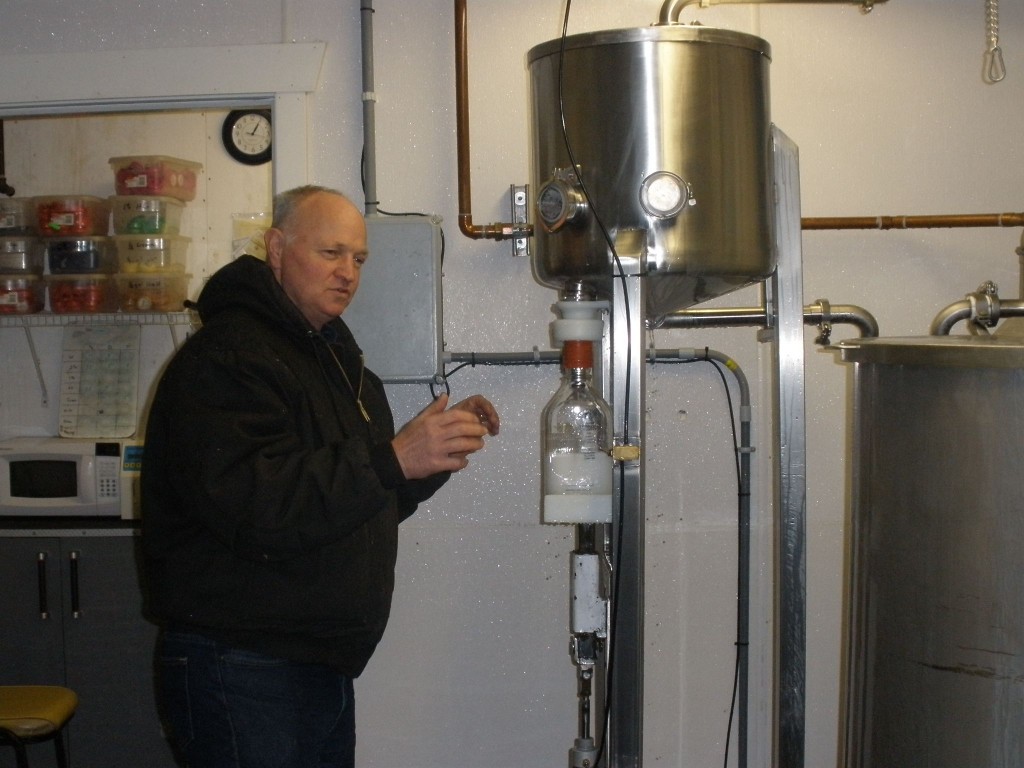
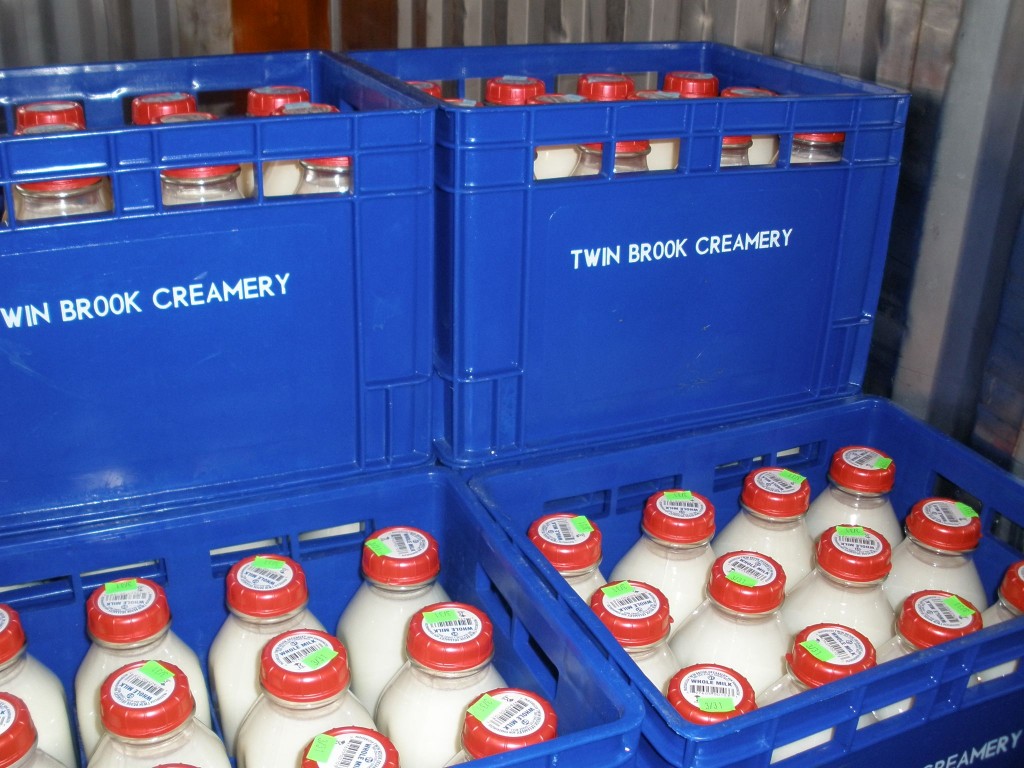
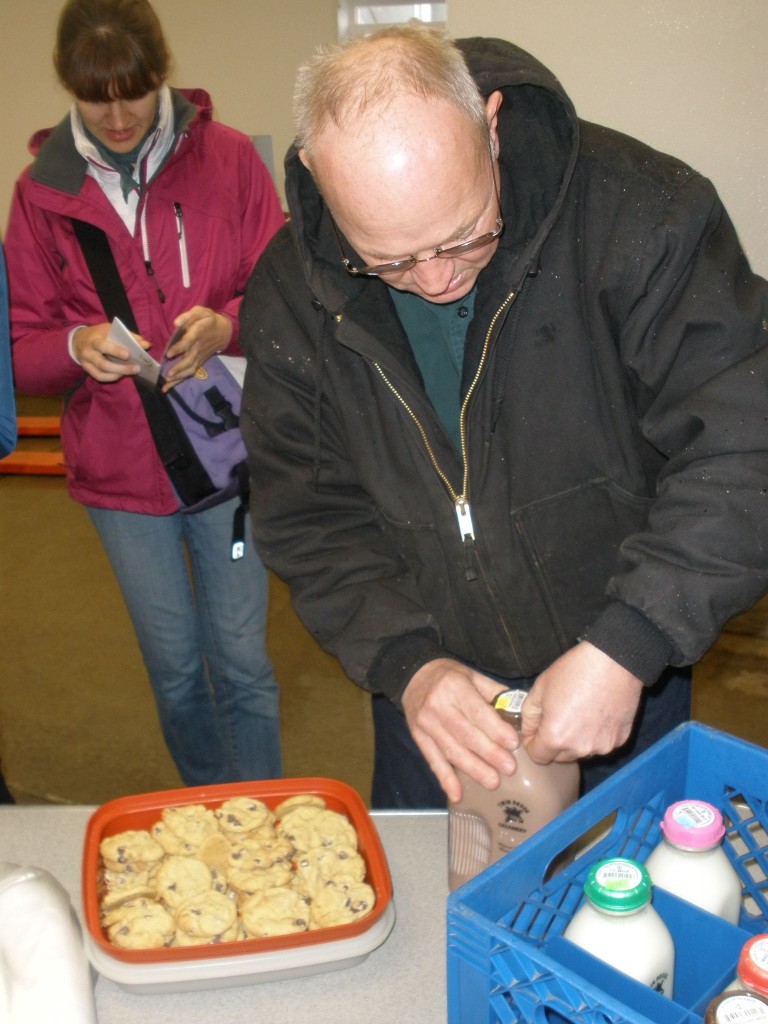
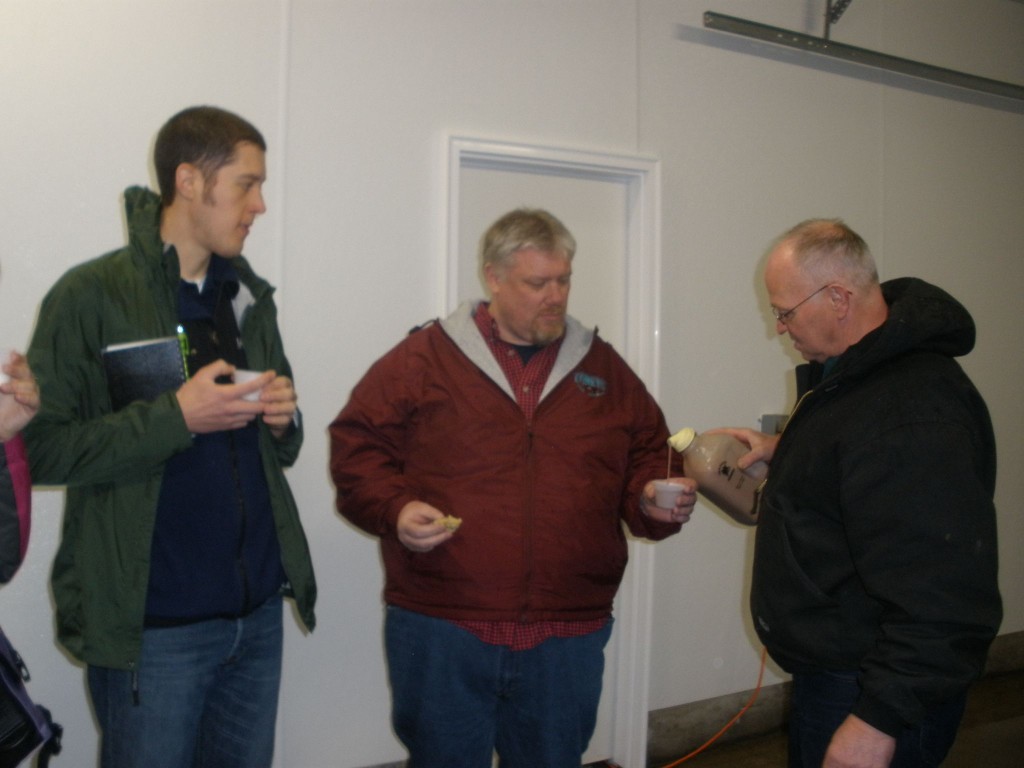
There used to be nearly innumerable dairy farms in Whatcom County, and now there are only 125. Less than ten of these are independent producers. Larry says he’s intent on getting the business set up for the next generation, and leaving a legacy for generations to come. Mark and Michelle’s children –– Larry’s grandkids –– will be 6th generation dairy farmers, and the Stap family will possibly be the only dairy family in the region to operate on the same piece of property through the decades.
For a full list of places where you can buy Twin Brook products, visit their Facebook page.
~~~
*** (4/20/12) The UW Real Food Challenge student group, in partnership with UW Housing and Food Services, successfully hosted an Earth Day tasting of both Twin Brook Creamery Chocolate Milk and Belly Timber Bars in the primary residential dining hall. They collected nearly 200 student petitions to stock the products on campus. UW plans to do a Real Food Challenge assessment of food on campus this summer, through which product shifts such as these are recorded, and earn the school credit, incentivizing the shift.***
For more pictures of our weekend tour, check out our Facebook album.
Check out our blog post about the first ever national Food Day, for which Belly Timber and Twin Brook both donated products to UW’s Real Food Challenge food/sustainability event.
You can follow our work with universities in the PNW region via the Real Food Challenge NW Facebook Page
